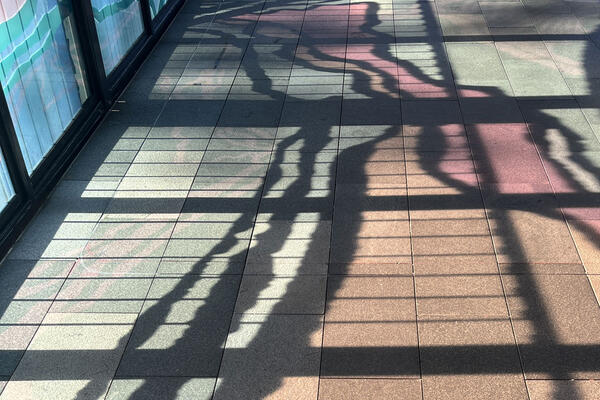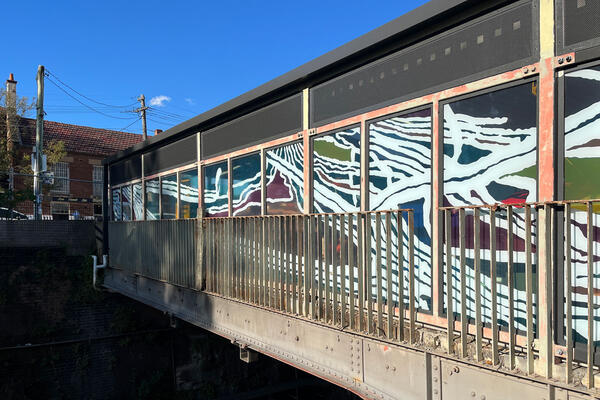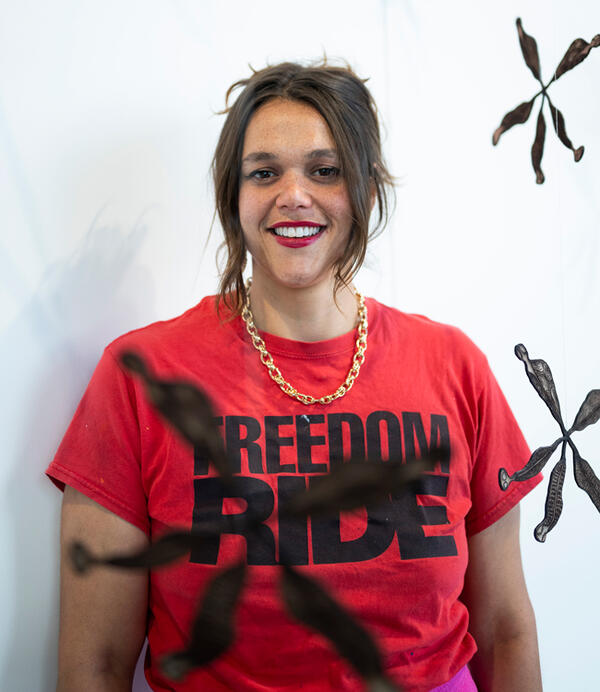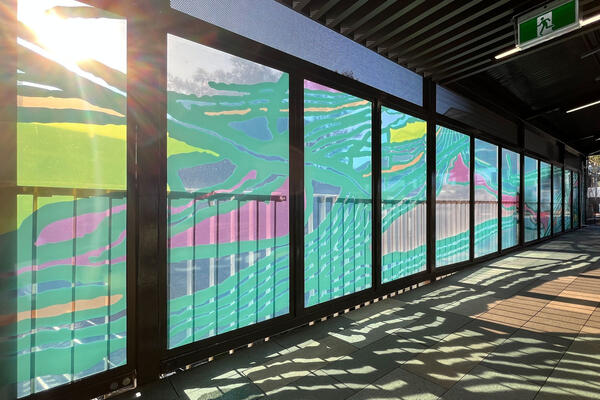
Tracks
Abstract lines flow across this artwork to trace the rivers and routes, walking tracks and railway lines that are entwined, overlayed and obscured in the coming together of Aboriginal and non-Aboriginal histories.
Image

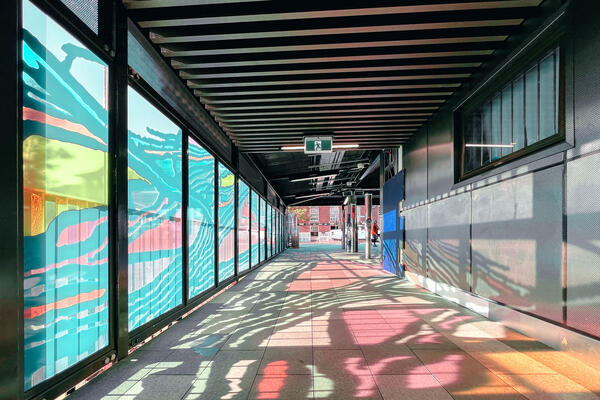
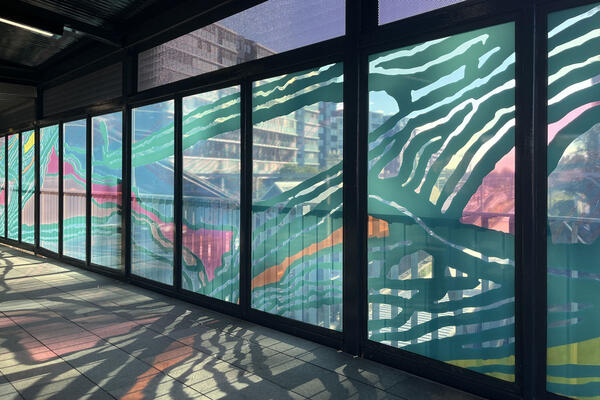
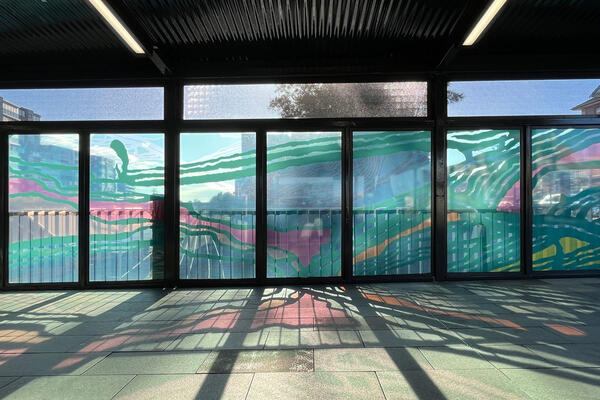
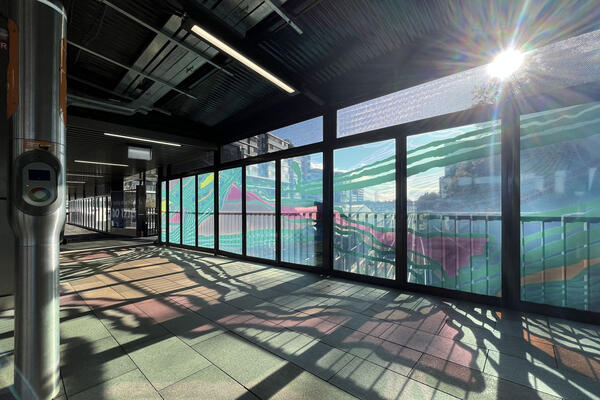
Image controls:
About the artwork
Maddison Gibbs’ Tracks is located on the concourse bridge at the entrance to Canterbury Station. It forms part of the suite of transparent artworks in station concourse windows at the 10 metro stations, from Marrickville to Bankstown, united by the theme Story Line.
Fluid lines weave seamlessly across the artwork to connect the multiple timelines of past, present and future, understood to be concurrent in Aboriginal placemaking. They symbolise the local river system and walking tracks, as well as the built overlay of buildings and bridges, roads and rail tracks. Rocks, eels, fish and fish traps, middens and significant cultural sites, weather patterns and natural cycles are layered within.
Canterbury Station was identified in consultation with First Nations stakeholders, as being a location of particular Indigenous Heritage significance for the upgrade of the T3 Bankstown Line to metro standards. First Nations artist Maddison Gibbs, a proud Barkindji woman, consulted with the Canterbury Bankstown Aboriginal Reference Group in the development of the concept for this work.
Gibbs’ practice is strongly grounded in her Aboriginal Culture. Her work employs culturally feminine and intuitive visual poetics. She is an artist and an activist and the dual sensitivities of caring for country, and fighting injustice, are explored throughout her practice.
Artist Statement
"Tracks centres on the Cooks River, as well as the Georges and Nepean Rivers, that are part of the same river system. Water is life - and these waters, and their surrounding lands, communities and built environments, have histories of multiple use for both Aboriginal, and non-Aboriginal, peoples. Inspiration for this artwork was found at the river - spending time, sitting on country, listening to the water memory - which continues to flow.
In Aboriginal placemaking, the past, present and future is concurrent - and the artwork speaks to the simultaneity of these dual Aboriginal and non-aboriginal histories. The abstract lines that thread through the artwork represent a layering of the natural river system, early colonial routes, and the infrastructure of the contemporary metropolis.
The lines represent tracks that are both visible and invisible. Traditional Aboriginal Songlines have been made invisible by the super-imposition of colonial and contemporary infrastructure. The artwork enquires about what lies beneath the visible layers - about what has become invisible, and therefore, uncelebrated."
Artist Biography
Maddison Gibbs is a proud Barkindji woman who grew up in Dubbo, NSW. She currently lives and works between Sydney and Kandos, NSW.
Gibbs is an emerging, multidisciplinary artist whose practice focusses on stories of past and present Aboriginal societies, and spirit. She explores intergenerational stories of contemporary Aboriginal affairs, with a focus on telling women’s narratives.
Her artworks are based on her culture, people and surroundings. They tell stories of past and present by using contemporary methods and ideologies.
Her works include political statements and educational information regarding Aboriginal issues, a subject which she is extremely passionate about. She employs a range of different mediums including drawing, ceramics, printmaking and animation.
She is an artist and an activist. The dual sensitivities of caring for country, and fighting injustice, are explored throughout her practice.
Gibbs studied Aboriginal and Torres Strait Islander Cultural Arts at Eora College in Sydney and a Bachelor of Animation at the University of Technology Sydney.
Her artworks have been included as part of Vivid Festival, Sydney Fringe Festival, Hobiennale at Moonah Arts Centre in Tasmania, and the Bankstown Biennale. She has exhibited in group WCGW.
Gibbs has completed several public art murals and worked on the restoration of the 40,000 years mural at The Block, Redfern. She was recently commissioned to create a large-scale public artwork for the new Eveleigh Precinct in Sydney. In 2019 she was the recipient of the Australian Museum’s prestigious Young Indigenous Artist Fellowship and has been awarded the Rotary Club of Sydney Soukup Animation Grant and the Bob Morgan International Scholarship.

